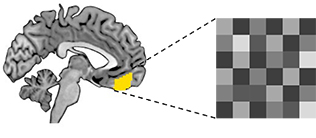New approach towards an improved treatment of anxiety disorders

The researchers have been analyzing more closely the mental processes that underlie the resulting positive memory formation processes. Their findings, now published in Nature Communications, could help improve the treatment of anxiety-related problems and post-traumatic stress disorder (PTSD) and aid in the development of appropriate preventive measures.
The human brain is continually changing and can be (re)shaped by experiences – both good and bad. This is the basic premise underlying resilience research and the therapies used to treat phobias and anxiety disorders.
But how do some people manage to reduce their fear, or even make use of it and turn it into new, positive experiences when confronted with a situation that would previously have terrified them? And why does this mechanism called fear extinction fail to work for other people over the long term?
How does an individual's brain form and stabilize long-term memories and what is the role played by factors such as spontaneous neural consolidation processes, which occur after a new, positive experience is learned? These are the questions at the heart of the work carried out by Professor Raffael Kalisch and Dr. Anna M.V. Gerlicher together with researchers of the German Resilience Center (DRZ) and the Collaborative Research Center 1193 “Neurobiology of resilience to stress-induced mental dysfunction: from understanding mechanisms to promoting prevention” at the Mainz University Medical Center.
“We already have a pretty good understanding of the neural processes that are relevant to learning that a fear-inducing stimulus no longer presents a threat. Recent studies have shown, however, that it is very important to be able to clearly remember these learning experiences. This is the only way to avoid repeatedly falling prey to unnecessary fear responses and to thus become resilient to developing a post-traumatic stress disorder,” explained Dr. Anna Gerlicher, first author of the study paper. “Therefore, we focused fully on the question of how, after such an extinction learning process, the learned experience can be consolidated in our memory.”
The team led by DRZ research group leader Professor Raffael Kalisch discovered that the brains of their test subjects exhibited specific activation patterns during an extinction learning experience, which spontaneously reappeared in a rest phase after the learning phase.
The more frequently these spontaneous reactivations occurred, the better the subjects were able to recall their positive experience on a subsequent test day and the less marked were their fear responses to stimuli that would otherwise have triggered the fear response.
They also discovered that the activity patterns relevant to the memories were dependent on the neurotransmitter dopamine, known as the reward hormone.
“A particularly fascinating aspect for us was that by administering a commercially available drug that intervenes in cerebral biochemistry and causes an increase in the brain's dopamine levels after extinction learning, we were able to increase the number of reactivations so that subsequent fear responses were reduced to the same extent. In essence, we discovered that fear extinction memories can be relatively easily reinforced, at least in the laboratory, and in fact without any further practice or memory training,” added Kalisch.
The researchers see their findings as offering potential for gaining new insights into the fundamental mechanisms of memory formation and for developing possible new ways to improve the prevention and treatment of post-traumatic stress.
Press contact:
Barbara Reinke
Corporate Communications
Mainz University Medical Center
Langenbeckstr. 1
55131 Mainz, GERMANY
phone +49 6131 17-7424
fax +49 6131 17-3496
e-mail: pr@unimedizin-mainz.de
http://www.unimedizin-mainz.de/index.php?id=240&L=1
About the University Medical Center of Johannes Gutenberg University Mainz
The University Medical Center of Johannes Gutenberg University Mainz is the only medical facility providing supramaximal care in Rhineland-Palatinate while also functioning as an internationally recognized hub of medical science. It has more than 60 clinics, institutes, and departments that collaborate across the various disciplines. Highly specialized patient care, research, and teaching form an integral whole at the Mainz University Medical Center. Approximately 3,300 students are trained in medicine and dentistry in Mainz. With its approximately 7,500 personnel, the Mainz University Medical Center is also one of the largest employers in the region and an important driver of growth and innovation. Further information is available online at http://www.unimedizin-mainz.de/index.php?id=240&L=1
Professor Dr. Raffael Kalisch
Head of the Neuroimaging Center at the Mainz University Medical Center
Langenbeckstr. 1
55131 Mainz, GERMANY
phone +49 6131 17-4588
e-mail: rkalisch@uni-mainz.de
http://www.ftn.nic.uni-mainz.de/kalisch-lab
A. M. V. Gerlicher, O. Tüscher, R. Kalisch, Dopamine-dependent prefrontal reactivations explain long-term benefit of fear extinction, Nature Communications 9:4294, 16 October 2018,
DOI:10.1038/s41467-018-06785-y
Media Contact
More Information:
http://www.unimedizin-mainz.de/All latest news from the category: Health and Medicine
This subject area encompasses research and studies in the field of human medicine.
Among the wide-ranging list of topics covered here are anesthesiology, anatomy, surgery, human genetics, hygiene and environmental medicine, internal medicine, neurology, pharmacology, physiology, urology and dental medicine.
Newest articles

NASA: Mystery of life’s handedness deepens
The mystery of why life uses molecules with specific orientations has deepened with a NASA-funded discovery that RNA — a key molecule thought to have potentially held the instructions for…

What are the effects of historic lithium mining on water quality?
Study reveals low levels of common contaminants but high levels of other elements in waters associated with an abandoned lithium mine. Lithium ore and mining waste from a historic lithium…

Quantum-inspired design boosts efficiency of heat-to-electricity conversion
Rice engineers take unconventional route to improving thermophotovoltaic systems. Researchers at Rice University have found a new way to improve a key element of thermophotovoltaic (TPV) systems, which convert heat…



